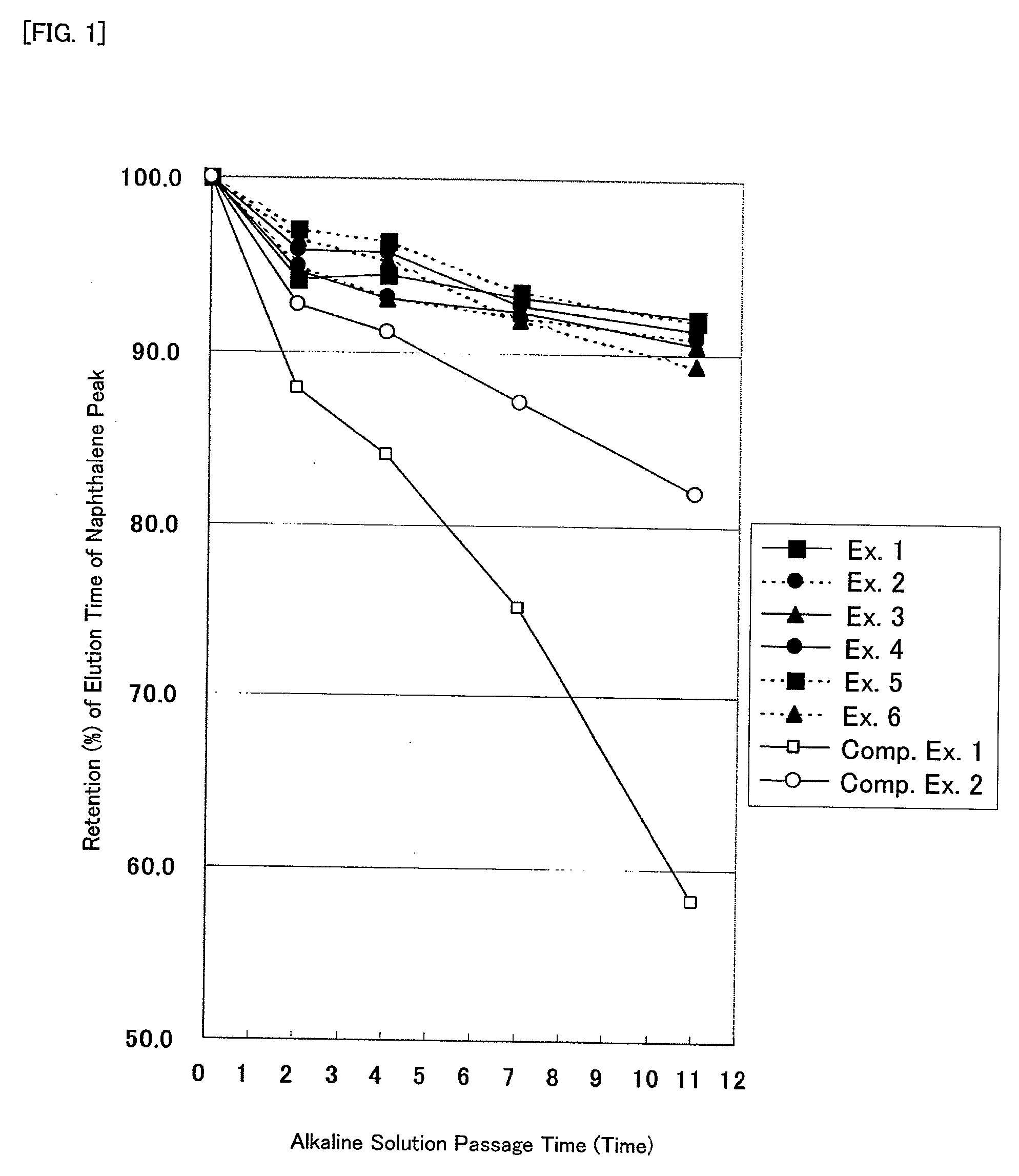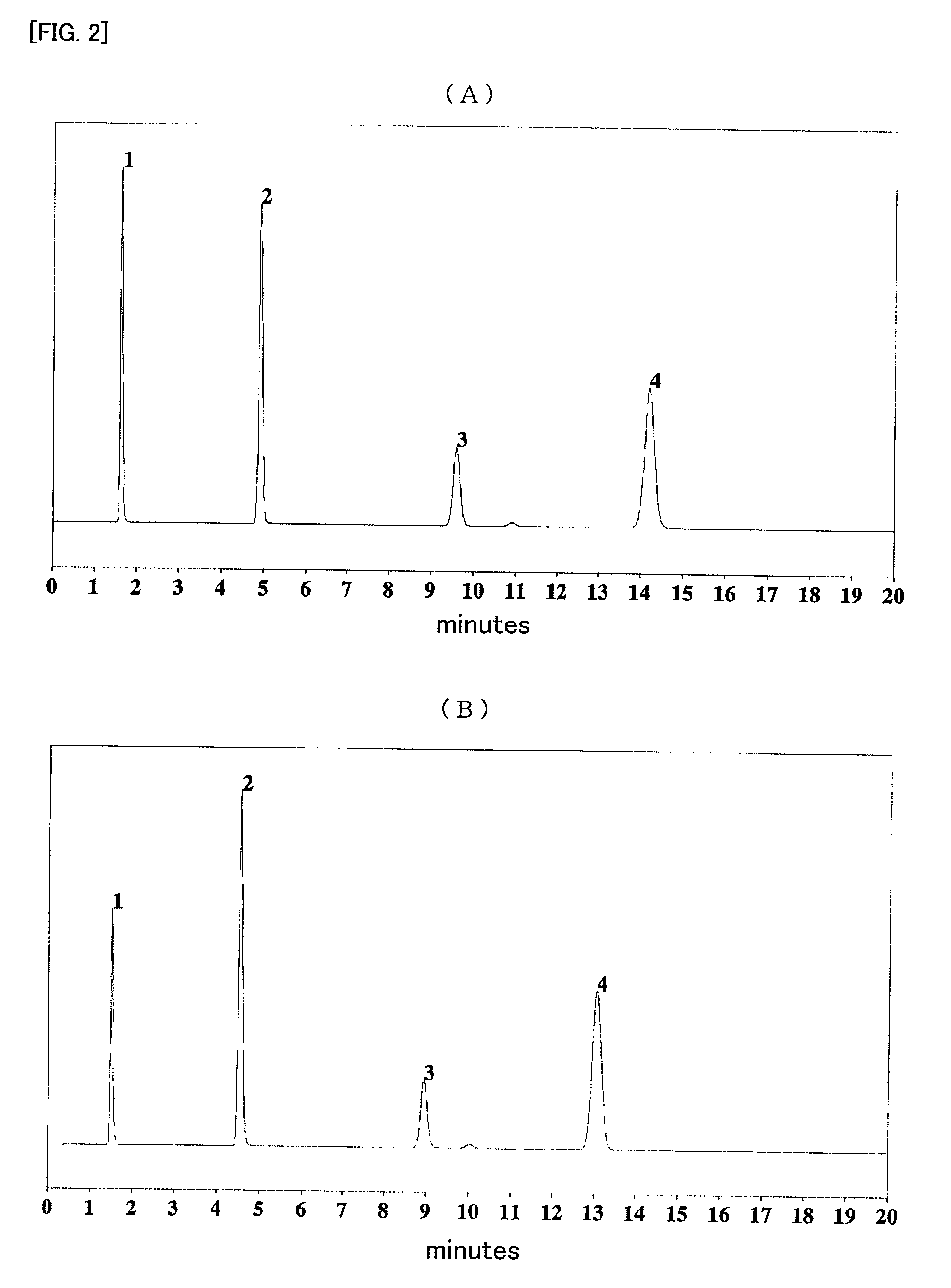Modified silica gel and use thereof
a technology of silica gel and modified alkyl group, which is applied in the field of modified silica gel, can solve the problems that silica gel modified with alkyl group cannot also avoid deterioration under alkaline conditions, reduce the number of theoretical plates or changes in peak shapes, and achieve excellent separation performance, excellent resistance to alkaline solutions, and retain separation performance
- Summary
- Abstract
- Description
- Claims
- Application Information
AI Technical Summary
Benefits of technology
Problems solved by technology
Method used
Image
Examples
example 1
[0109]Using a 300 ml three-necked flask, 30 g of Daisogel SP-120-5P (a highly pure spherical silica gel, average particle diameter: 5 μm; pore size: 120 Å; surface area: 300 m2 / g) was subjected to azeotropic dehydration in 150 ml of toluene in a nitrogen atmosphere, and subsequently 5.5 g of bis(trichlorosilyl)methane and 9.4 g of pyridine were added thereto, and the mixture was refluxed while heating for 4 hours. After cooling to room temperature, 2.0 g of pure water was added to the resulting product, and the mixture was refluxed for 2 hours until the hydrolysis reaction was completed. After cooling to room temperature, the reaction product was again subjected to azeotropic dehydration, and then 14.1 g of octadecyldimethylchlorosilane and 3.5 g of pyridine were added thereto, and the mixture was refluxed while heating for 4 hours. After cooling to room temperature, 3.9 g of trimethylchlorosilane and 2.9 g of pyridine were added to the resulting product for endcapping, and the mixt...
example 2
[0110]The procedure of Example 1 was repeated, except that bis(trichlorosilyl)ethane was used as an alkyldisilane compound instead of bis(trichlorosilyl)methane.
[0111]More specifically, using a 300 ml three-necked flask, 30 g of Daisogel SP-120-5P (a highly pure spherical silica gel, average particle diameter: 5 μm; pore size: 120 Å; surface area: 300 m2 / g) was subjected to azeotropic dehydration in 150 ml of toluene in a nitrogen atmosphere, and subsequently 5.8 g of bis(trichlorosilyl)ethane and 9.4 g of pyridine were added thereto, and the mixture was refluxed while heating for 4 hours. After cooling to room temperature, 2.0 g of pure water was added to the resulting product, and the mixture was refluxed for 2 hours until the hydrolysis reaction was completed. After cooling to room temperature, the reaction product was again subjected to azeotropic dehydration, and then 14.1 g of octadecyldimethylchlorosilane and 3.5 g of pyridine were added thereto, and the mixture was refluxed ...
example 3
[0112]The procedure of Example 1 was repeated, except that bis(trichlorosilyl)propane was used as an alkyldisilane compound instead of bis(trichlorosilyl)methane.
[0113]More specifically, using a 300 ml three-necked flask, 30 g of Daisogel SP-120-5P (a highly pure spherical silica gel, average particle diameter: 5 μm; pore size: 120 Å; surface area: 300 m2 / g) was subjected to azeotropic dehydration in 150 ml of toluene in a nitrogen atmosphere, and subsequently 6.1 g of bis(trichlorosilyl)propane and 9.4 g of pyridine were added thereto, and the mixture was refluxed while heating for 4 hours. After cooling to room temperature, 2.0 g of pure water was added to the resulting product, and the mixture was refluxed for 2 hours until the hydrolysis reaction was completed. After cooling to room temperature, the reaction product was again subjected to azeotropic dehydration, and then 14.1 g of octadecyldimethylchlorosilane and 3.5 g of pyridine were added thereto, and the mixture was refluxe...
PUM
| Property | Measurement | Unit |
|---|---|---|
| Reaction temperature | aaaaa | aaaaa |
| Reaction temperature | aaaaa | aaaaa |
| Fraction | aaaaa | aaaaa |
Abstract
Description
Claims
Application Information
 Login to View More
Login to View More - R&D
- Intellectual Property
- Life Sciences
- Materials
- Tech Scout
- Unparalleled Data Quality
- Higher Quality Content
- 60% Fewer Hallucinations
Browse by: Latest US Patents, China's latest patents, Technical Efficacy Thesaurus, Application Domain, Technology Topic, Popular Technical Reports.
© 2025 PatSnap. All rights reserved.Legal|Privacy policy|Modern Slavery Act Transparency Statement|Sitemap|About US| Contact US: help@patsnap.com



